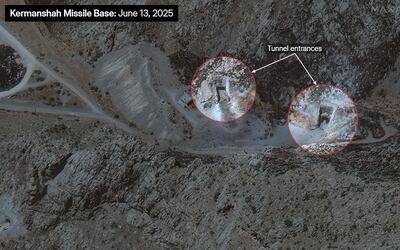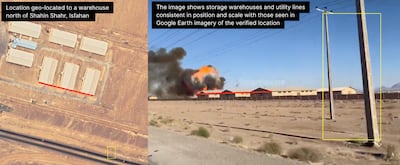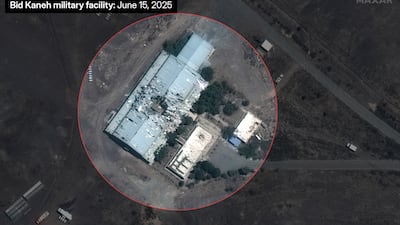New satellite imagery has revealed the scale of destruction from Israel’s latest wave of air strikes on Iran, with some of the country’s most sensitive nuclear and missile factories hit. Our analysis shows that at least two of Iran’s five key nuclear sites suffered significant damage, raising concerns about the potential risk of contamination.
So, what exactly was struck, and is there a risk of a nuclear leak?
Since the attacks directly on nuclear energy sites, UN watchdog the International Atomic Energy Agency has warned of a risk of radiological or chemical contamination due to the attacks.
However, radiation levels outside the factories currently remain within normal limits, and no leak has been detected.
Although the strikes primarily focused on military and nuclear infrastructure, the civilian toll is rising. Iran’s Health Ministry has confirmed that at least 224 people have been killed and more than 1,200 injured in the wave of Israeli attacks, figures that underline the human cost beyond military or energy targets.
Natanz nuclear enrichment plant
One of the most heavily struck sites was Natanz, a factory at the heart of Iran’s uranium enrichment programme. Satellite images captured on June 14 show damage to at least five structures at the complex, where thousands of centrifuges are housed. These centrifuges are used to enrich uranium, a key material for civilian nuclear energy but also a potential pathway to developing nuclear weapons.
Before and after images show at least five damaged structures. Satellite footage from June 14 reveals direct hits to areas previously containing advanced centrifuges. Plumes of black smoke seen in social media videos on June 13 corroborate the timing and severity of the strike.
Over the past three years, Natanz has been the site where Iran has produced most of its enriched uranium stockpile, including quantities enriched to near weapons-grade levels. This has brought the country significantly closer to the technical threshold required to build a nuclear weapon, according to western intelligence assessments.
The IAEA has since confirmed “direct impacts” on underground enrichment halls is a significant development. Although radiation levels remain normal, UN inspectors have raised concerns about potential chemical or radiological contamination within the complex.
North Tabriz military site
The Tabriz complex in north-western Iran is believed to be the country’s second-largest major missile base with underground silos. Its location suggests that parts of eastern and central Europe could be within range of missiles launched from the site. According to the Nuclear Threat Initiative, the base appears to house mobile launchers for Shahab-1, Shahab-2 and possibly Shahab-3 ballistic missiles. Also believed to be present are two reinforced silos, thought to contain Shahab-2 or Shahab-3 missiles. The surrounding mountainous terrain and hardened structures are designed to protect the missiles in the event of an attack. Israeli sources estimate the launch area covers about 50,000 square kilometres.
The nearby Tabriz International Airport was also struck by Israel, with images showing significant damage to runways.
Kermanshah: IRGC tunnel complex hit
Another set of newly published satellite images shows extensive damage to another missile base run by Iran's Islamic Revolutionary Guard Corps near the western province of Kermanshah. A close-up from the base shows damage to the entrance, believed to lead to an underground missiles storage centre.
The full impact on Iran's military is yet to be determined, but the latest images strongly suggest that Israel's strikes have been successful in hindering at least part of Tehran's missile capability.
Storage warehouse
Not all targets are known military sites or nuclear factories. Social media footage geolocated by The National shows a huge explosion at a named warehouse located north of Shahin Shahr in Isfahan.
Centrifuges the target
The IAEA has confirmed Israel hit the Natanz's underground centrifuge halls and two other centrifuge production factories.
But what is the significance, and why are centrifuges an essential component of nuclear energy?
On June 9, the Institute for Science and International Security published a study summarising information in the IAEA's quarterly report.
The document stated that as of May 17, Iran had more than 14,500 advanced centrifuges installed at the Natanz and Fordow fuel enrichment plants. It said Iran was undertaking “the near-final step” of breaking out from the restrictions of the 2015 nuclear agreement, converting its 20 per cent stock of enriched uranium into 60 per cent enriched uranium at a greatly expanded rate.
Although Israel appears to have successfully degraded Iran’s ability to rapidly scale up a nuclear breakout or missile use in the short term, such losses do not appear irrecoverable. Iran has demonstrated resilience and redundancy over the decades across its nuclear infrastructure, often dispersing key assets and maintaining deep underground factories specifically to survive such attacks.
The IAEA has called for calm and access to inspect affected sites. For now, satellite imagery remains one of the few reliable ways to track the scale and precision of these strikes. The picture that’s emerging is clear: Israel has delivered a major tactical blow to Iran’s infrastructure, but the long-term consequences, both strategic and environmental, are not yet known.
England's lowest Test innings
- 45 v Australia in Sydney, January 28, 1887
- 46 v West Indies in Port of Spain, March 25, 1994
- 51 v West Indies in Kingston, February 4, 2009
- 52 v Australia at The Oval, August 14, 1948
- 53 v Australia at Lord's, July 16, 1888
- 58 v New Zealand in Auckland, March 22, 2018
If you go
The flights
Emirates flies from Dubai to Seattle from Dh5,555 return, including taxes.
The car
Hertz offers compact car rental from about $300 (Dh1,100) per week, including taxes. Emirates Skywards members can earn points on their car hire through Hertz.
The national park
Entry to Mount Rainier National Park costs $30 for one vehicle and passengers for up to seven days. Accommodation can be booked through mtrainierguestservices.com. Prices vary according to season. Rooms at the Holiday Inn Yakima cost from $125 per night, excluding breakfast.
ODI FIXTURE SCHEDULE
First ODI, October 22
Wankhede Stadium, Mumbai
Second ODI, October 25
Maharashtra Cricket Association Stadium, Pune
Third ODI, October 29
Venue TBC
Killing of Qassem Suleimani
Groom and Two Brides
Director: Elie Semaan
Starring: Abdullah Boushehri, Laila Abdallah, Lulwa Almulla
Rating: 3/5
Wicked: For Good
Director: Jon M Chu
Starring: Ariana Grande, Cynthia Erivo, Jonathan Bailey, Jeff Goldblum, Michelle Yeoh, Ethan Slater
Rating: 4/5
How to apply for a drone permit
- Individuals must register on UAE Drone app or website using their UAE Pass
- Add all their personal details, including name, nationality, passport number, Emiratis ID, email and phone number
- Upload the training certificate from a centre accredited by the GCAA
- Submit their request
What are the regulations?
- Fly it within visual line of sight
- Never over populated areas
- Ensure maximum flying height of 400 feet (122 metres) above ground level is not crossed
- Users must avoid flying over restricted areas listed on the UAE Drone app
- Only fly the drone during the day, and never at night
- Should have a live feed of the drone flight
- Drones must weigh 5 kg or less
'Outclassed in Kuwait'
Taleb Alrefai,
HBKU Press
NBA Finals results
Game 1: Warriors 124, Cavaliers 114
Game 2: Warriors 122, Cavaliers 103
Game 3: Cavaliers 102, Warriors 110
Game 4: In Cleveland, Sunday (Monday morning UAE)
MATCH INFO
Europa League final
Who: Marseille v Atletico Madrid
Where: Parc OL, Lyon, France
When: Wednesday, 10.45pm kick off (UAE)
TV: BeIN Sports
MATCH INFO
Uefa Champions League semi-final, first leg
Bayern Munich v Real Madrid
When: April 25, 10.45pm kick-off (UAE)
Where: Allianz Arena, Munich
Live: BeIN Sports HD
Second leg: May 1, Santiago Bernabeu, Madrid
BUNDESLIGA FIXTURES
Friday Stuttgart v Cologne (Kick-off 10.30pm UAE)
Saturday RB Leipzig v Hertha Berlin (5.30pm)
Mainz v Borussia Monchengladbach (5.30pm)
Bayern Munich v Eintracht Frankfurt (5.30pm)
Union Berlin v SC Freiburg (5.30pm)
Borussia Dortmund v Schalke (5.30pm)
Sunday Wolfsburg v Arminia (6.30pm)
Werder Bremen v Hoffenheim (9pm)
Bayer Leverkusen v Augsburg (11.30pm)
SPECS%3A%20Polestar%203
%3Cp%3E%3Cstrong%3EEngine%3A%20%3C%2Fstrong%3ELong-range%20dual%20motor%20with%20400V%20battery%3Cbr%3E%3Cstrong%3EPower%3A%20%3C%2Fstrong%3E360kW%20%2F%20483bhp%3Cbr%3E%3Cstrong%3ETorque%3A%20%3C%2Fstrong%3E840Nm%3Cbr%3E%3Cstrong%3ETransmission%3A%20%3C%2Fstrong%3ESingle-speed%20automatic%3Cbr%3E%3Cstrong%3EMax%20touring%20range%3A%3C%2Fstrong%3E%20628km%3Cbr%3E%3Cstrong%3E0-100km%2Fh%3A%3C%2Fstrong%3E%204.7sec%3Cbr%3E%3Cstrong%3ETop%20speed%3A%3C%2Fstrong%3E%20210kph%20%3Cbr%3E%3Cstrong%3EPrice%3A%20%3C%2Fstrong%3EFrom%20Dh360%2C000%3Cbr%3E%3Cstrong%3EOn%20sale%3A%20%3C%2Fstrong%3ESeptember%3Cbr%3E%3C%2Fp%3E%0A
Most%20polluted%20cities%20in%20the%20Middle%20East
%3Cp%3E1.%20Baghdad%2C%20Iraq%3Cbr%3E2.%20Manama%2C%20Bahrain%3Cbr%3E3.%20Dhahran%2C%20Saudi%20Arabia%3Cbr%3E4.%20Kuwait%20City%2C%20Kuwait%3Cbr%3E5.%20Ras%20Al%20Khaimah%2C%20UAE%3Cbr%3E6.%20Ash%20Shihaniyah%2C%20Qatar%3Cbr%3E7.%20Abu%20Dhabi%2C%20UAE%3Cbr%3E8.%20Cairo%2C%20Egypt%3Cbr%3E9.%20Riyadh%2C%20Saudi%20Arabia%3Cbr%3E10.%20Dubai%2C%20UAE%3C%2Fp%3E%0A%3Cp%3E%3Cem%3ESource%3A%202022%20World%20Air%20Quality%20Report%3C%2Fem%3E%3C%2Fp%3E%0A
MOST%20POLLUTED%20COUNTRIES%20IN%20THE%20WORLD
%3Cp%3E1.%20Chad%3Cbr%3E2.%20Iraq%3Cbr%3E3.%20Pakistan%3Cbr%3E4.%20Bahrain%3Cbr%3E5.%20Bangladesh%3Cbr%3E6.%20Burkina%20Faso%3Cbr%3E7.%20Kuwait%3Cbr%3E8.%20India%3Cbr%3E9.%20Egypt%3Cbr%3E10.%20Tajikistan%3Cbr%3E%3Cbr%3E%3Cem%3ESource%3A%202022%20World%20Air%20Quality%20Report%3C%2Fem%3E%3C%2Fp%3E%0A
Miss Granny
Director: Joyce Bernal
Starring: Sarah Geronimo, James Reid, Xian Lim, Nova Villa
3/5
(Tagalog with Eng/Ar subtitles)
MOUNTAINHEAD REVIEW
Starring: Ramy Youssef, Steve Carell, Jason Schwartzman
Director: Jesse Armstrong
Rating: 3.5/5
2025 Fifa Club World Cup groups
Group A: Palmeiras, Porto, Al Ahly, Inter Miami.
Group B: Paris Saint-Germain, Atletico Madrid, Botafogo, Seattle.
Group C: Bayern Munich, Auckland City, Boca Juniors, Benfica.
Group D: Flamengo, ES Tunis, Chelsea, Leon.
Group E: River Plate, Urawa, Monterrey, Inter Milan.
Group F: Fluminense, Borussia Dortmund, Ulsan, Mamelodi Sundowns.
Group G: Manchester City, Wydad, Al Ain, Juventus.
Group H: Real Madrid, Al Hilal, Pachuca, Salzburg.
More from Rashmee Roshan Lall
THE CLOWN OF GAZA
Director: Abdulrahman Sabbah
Starring: Alaa Meqdad
Rating: 4/5
Turning%20waste%20into%20fuel
%3Cp%3EAverage%20amount%20of%20biofuel%20produced%20at%20DIC%20factory%20every%20month%3A%20%3Cstrong%3EApproximately%20106%2C000%20litres%3C%2Fstrong%3E%3C%2Fp%3E%0A%3Cp%3EAmount%20of%20biofuel%20produced%20from%201%20litre%20of%20used%20cooking%20oil%3A%20%3Cstrong%3E920ml%20(92%25)%3C%2Fstrong%3E%3C%2Fp%3E%0A%3Cp%3ETime%20required%20for%20one%20full%20cycle%20of%20production%20from%20used%20cooking%20oil%20to%20biofuel%3A%20%3Cstrong%3EOne%20day%3C%2Fstrong%3E%3C%2Fp%3E%0A%3Cp%3EEnergy%20requirements%20for%20one%20cycle%20of%20production%20from%201%2C000%20litres%20of%20used%20cooking%20oil%3A%3Cbr%3E%3Cstrong%3E%E2%96%AA%20Electricity%20-%201.1904%20units%3Cbr%3E%E2%96%AA%20Water-%2031%20litres%3Cbr%3E%E2%96%AA%20Diesel%20%E2%80%93%2026.275%20litres%3C%2Fstrong%3E%3C%2Fp%3E%0A
The specs
Engine: Dual 180kW and 300kW front and rear motors
Power: 480kW
Torque: 850Nm
Transmission: Single-speed automatic
Price: From Dh359,900 ($98,000)
On sale: Now
The Sand Castle
Director: Matty Brown
Stars: Nadine Labaki, Ziad Bakri, Zain Al Rafeea, Riman Al Rafeea
Rating: 2.5/5
The five pillars of Islam
EA Sports FC 26
Publisher: EA Sports
Consoles: PC, PlayStation 4/5, Xbox Series X/S
Rating: 3/5
Company profile
Name: Infinite8
Based: Dubai
Launch year: 2017
Number of employees: 90
Sector: Online gaming industry
Funding: $1.2m from a UAE angel investor
Mohammed bin Zayed Majlis
HWJN
%3Cp%3EDirector%3A%20Yasir%20Alyasiri%3C%2Fp%3E%0A%3Cp%3EStarring%3A%20Baraa%20Alem%2C%20Nour%20Alkhadra%2C%20Alanoud%20Saud%3C%2Fp%3E%0A%3Cp%3ERating%3A%203%2F5%3C%2Fp%3E%0A%3Cp%3E%3C%2Fp%3E%0A
SPEC%20SHEET%3A%20SAMSUNG%20GALAXY%20S24%20ULTRA
%3Cp%3E%3Cstrong%3EDisplay%3A%3C%2Fstrong%3E%206.8%22%20quad-HD%2B%20dynamic%20Amoled%202X%2C%203120%20x%201440%2C%20505ppi%2C%20HDR10%2B%2C%20120Hz%3C%2Fp%3E%0A%3Cp%3E%3Cstrong%3EProcessor%3A%3C%2Fstrong%3E%204nm%20Qualcomm%20Snapdragon%208%20Gen%203%2C%2064-bit%20octa-core%3C%2Fp%3E%0A%3Cp%3E%3Cstrong%3EMemory%3A%3C%2Fstrong%3E%2012GB%20RAM%3C%2Fp%3E%0A%3Cp%3E%3Cstrong%3EStorage%3A%3C%2Fstrong%3E%20256%2F512GB%20%2F%201TB%3C%2Fp%3E%0A%3Cp%3E%3Cstrong%3EPlatform%3A%3C%2Fstrong%3E%20Android%2014%2C%20One%20UI%206.1%3C%2Fp%3E%0A%3Cp%3E%3Cstrong%3EMain%20camera%3A%3C%2Fstrong%3E%20quad%20200MP%20wide%20f%2F1.7%20%2B%2050MP%20periscope%20telephoto%20f%2F3.4%20with%205x%20optical%2F10x%20optical%20quality%20zoom%20%2B%2010MP%20telephoto%202.4%20with%203x%20optical%20zoom%20%2B%2012MP%20ultra-wide%20f%2F2.2%3B%20100x%20Space%20Zoom%3B%20auto%20HDR%2C%20expert%20RAW%3C%2Fp%3E%0A%3Cp%3E%3Cstrong%3EVideo%3A%3C%2Fstrong%3E%208K%4024%2F30fps%2C%204K%4030%2F60%2F120fps%2C%20full-HD%4030%2F60%2F240fps%2C%20full-HD%20super%20slo-mo%40960fps%3C%2Fp%3E%0A%3Cp%3E%3Cstrong%3EFront%20camera%3A%3C%2Fstrong%3E%2012MP%20f%2F2.2%3C%2Fp%3E%0A%3Cp%3E%3Cstrong%3EBattery%3A%3C%2Fstrong%3E%205000mAh%2C%20fast%20wireless%20charging%202.0%2C%20Wireless%20PowerShare%3C%2Fp%3E%0A%3Cp%3E%3Cstrong%3EConnectivity%3A%3C%2Fstrong%3E%205G%2C%20Wi-Fi%2C%20Bluetooth%205.3%2C%20NFC%3C%2Fp%3E%0A%3Cp%3E%3Cstrong%3EI%2FO%3A%3C%2Fstrong%3E%20USB-C%3B%20built-in%20Galaxy%20S%20Pen%3C%2Fp%3E%0A%3Cp%3E%3Cstrong%3EDurability%3A%3C%2Fstrong%3E%20IP68%2C%20up%20to%201.5m%20of%20freshwater%20up%20to%2030%20minutes%3B%20dust-resistant%26nbsp%3B%3C%2Fp%3E%0A%3Cp%3E%3Cstrong%3ESIM%3A%3C%2Fstrong%3E%20Nano%20%2B%20nano%20%2F%20nano%20%2B%20eSIM%20%2F%20dual%20eSIM%20(varies%20in%20different%20markets)%3C%2Fp%3E%0A%3Cp%3E%3Cstrong%3EColours%3A%3C%2Fstrong%3E%20Titanium%20black%2C%20titanium%20grey%2C%20titanium%20violet%2C%20titanium%20yellow%3C%2Fp%3E%0A%3Cp%3E%3Cstrong%3EIn%20the%20box%3A%20%3C%2Fstrong%3EGalaxy%20S24%20Ultra%2C%20USB-C-to-C%20cable%26nbsp%3B%3C%2Fp%3E%0A%3Cp%3E%3Cstrong%3EPrice%3A%3C%2Fstrong%3E%20Dh5%2C099%20for%20256GB%2C%20Dh5%2C599%20for%20512GB%2C%20Dh6%2C599%20for%201TB%3C%2Fp%3E%0A
UAE currency: the story behind the money in your pockets
More from Neighbourhood Watch:
if you go
The flights
Etihad and Emirates fly direct to Kolkata from Dh1,504 and Dh1,450 return including taxes, respectively. The flight takes four hours 30 minutes outbound and 5 hours 30 minute returning.
The trains
Numerous trains link Kolkata and Murshidabad but the daily early morning Hazarduari Express (3’ 52”) is the fastest and most convenient; this service also stops in Plassey. The return train departs Murshidabad late afternoon. Though just about feasible as a day trip, staying overnight is recommended.
The hotels
Mursidabad’s hotels are less than modest but Berhampore, 11km south, offers more accommodation and facilities (and the Hazarduari Express also pauses here). Try Hotel The Fame, with an array of rooms from doubles at Rs1,596/Dh90 to a ‘grand presidential suite’ at Rs7,854/Dh443.
More Iraq election coverage:
Story%20behind%20the%20UAE%20flag
%3Cp%3EThe%20UAE%20flag%20was%20first%20unveiled%20on%20December%202%2C%201971%2C%20the%20day%20the%20UAE%20was%20formed.%C2%A0%3C%2Fp%3E%0A%3Cp%3EIt%20was%20designed%20by%20Abdullah%20Mohammed%20Al%20Maainah%2C%2019%2C%20an%20Emirati%20from%20Abu%20Dhabi.%C2%A0%3C%2Fp%3E%0A%3Cp%3EMr%20Al%20Maainah%20said%20in%20an%20interview%20with%20%3Cem%3EThe%20National%3C%2Fem%3E%20in%202011%20he%20chose%20the%20colours%20for%20local%20reasons.%C2%A0%3C%2Fp%3E%0A%3Cp%3EThe%20black%20represents%20the%20oil%20riches%20that%20transformed%20the%20UAE%2C%20green%20stands%20for%20fertility%20and%20the%20red%20and%20white%20colours%20were%20drawn%20from%20those%20found%20in%20existing%20emirate%20flags.%3C%2Fp%3E%0A









